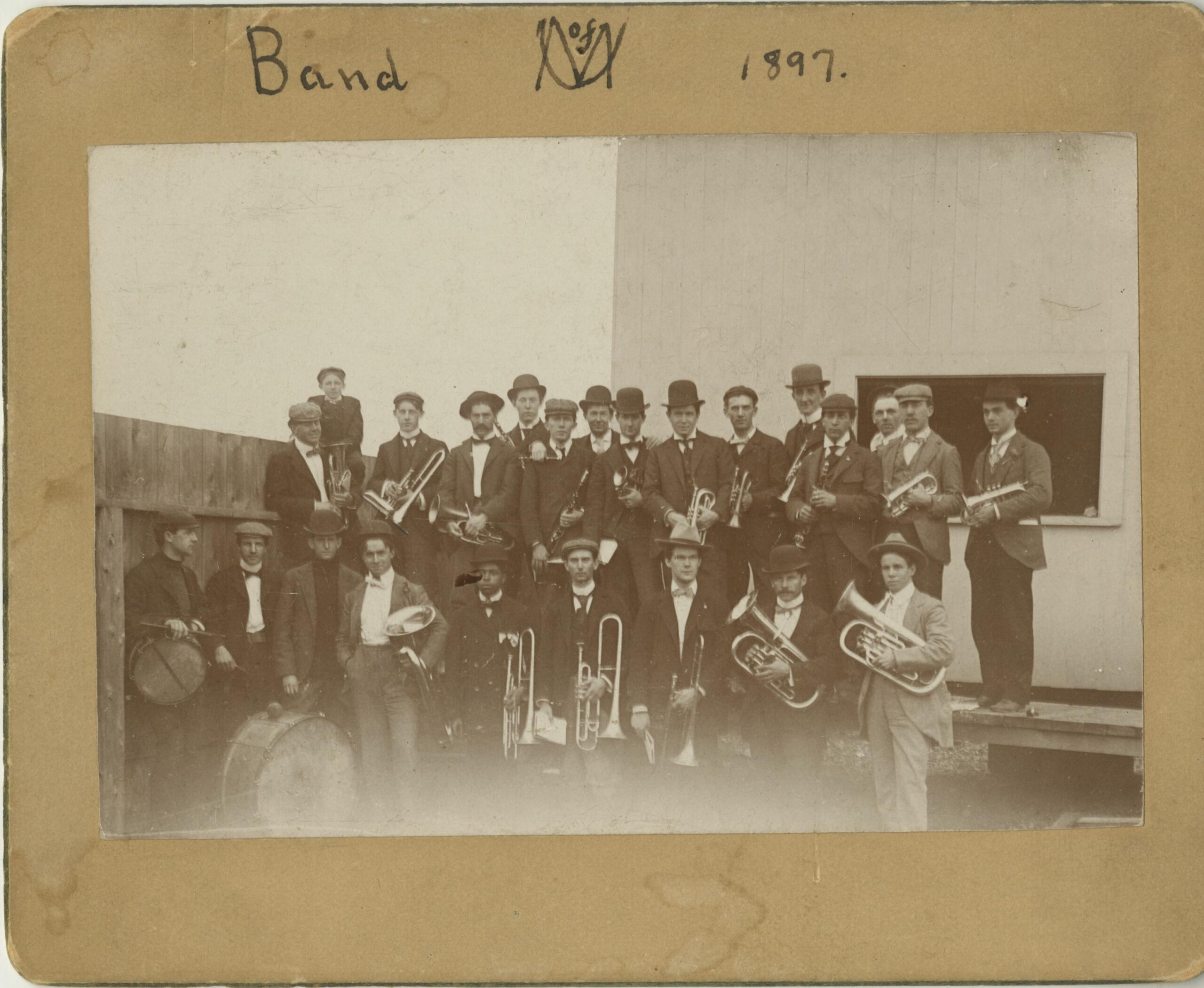This Sunday, October 23, will mark the 58th Band-O-Rama, an annual brass, wind, and percussion extravaganza – featuring the University of Michigan Symphony Band and Concert Band as well as the Michigan Marching Band – to celebrate and showcase the band program. This year’s Band-O-Rama takes place in the midst of a milestone year for the band program: its quasquicentennial, also known as its 125th anniversary.
Where It All Began
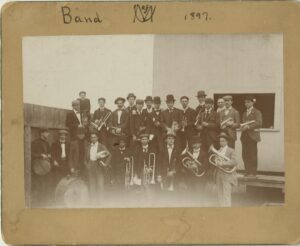
The University of Michigan Band in the first year of its existence, 1897.
While there was abundant music-making in the Ann Arbor area in the latter part of the 1800s, there was no University of Michigan band. Calls for a university band grew on campus in the 1890s – other nearby universities like University of Wisconsin, Ohio State University, and Michigan State University all had bands. Several attempts to organize a band at U-M had failed, until a group of students managed to gather nearly thirty musicians for an initial meeting in late 1896. This band took root, and on February 22, 1897, the University of Michigan Band gave its first public performance, at the annual observance of Washington’s Birthday, a major event on campus sponsored by the Law School.
The newly formed University of Michigan Band, commonly known as the University Band, soon became a popular ensemble on campus, playing at spring sporting events and other functions. The following fall, the band started playing at football games, launching what would become one of U-M’s most recognized and beloved traditions.
For many years, the University Band continued as a grassroots student club, scrambling to raise funds for uniforms, sheet music, and anything else they needed. In 1913, the University Regents agreed to make things official and fund the band, and by the fall of 1915, the university had hired the first salaried conductor, Wilfred Wilson. During Wilson’s tenure, the number of students in the band – which performed indoor concerts as well as at football games – more than doubled.
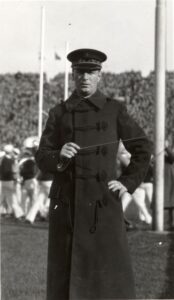
Nicholas Falcone, pictured here in Michigan Stadium, was the director of bands from 1927–34.
The hiring of Nicholas Falcone as band director in 1927 marked a significant turning point for the U-M band program. A conservatory-trained professional clarinet player, Falcone brought a new level of musicianship to the band, challenging the players with more difficult music, much of which he arranged himself. By bringing in officers from the university ROTC program to oversee the band’s on-field marching drills, he ushered in a new era of showmanship and military-style precision. Among Falcone’s most significant contributions was admitting the first African American – a gifted flute player named George Benjamin – and admitting women into the band. The women, however, were limited to playing concerts. The band that performed at football games would remain an all-male institution for another 50-plus years.
The Revelli Era
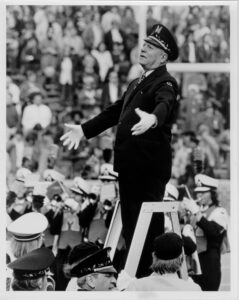
William D. Revelli, conducting the Marching Band at Michigan Stadium, 1969.
In the early 1930s, Falcone became ill, losing his hearing as a result. Soon after, in 1935, the university hired the man who would lead the program for decades, leaving his indelible stamp: William D. Revelli, a young high school band director from Hobart, Indiana. An intense and dynamic leader, Revelli took the Michigan band program by storm, quickly earning a reputation for exacting standards and an expectation of perfection. While he was not himself a military man, he brought a military precision to the U-M bands.
One of Revelli’s highest priorities as director was to take the band on the road. He understood the benefit for student musicians of such world-expanding experiences, and he also understood the value of spreading awareness of the program and recruiting new students. Joseph Dobos (BM ’71, MM ’72, music education), who was a member of the Marching Band and the Symphony Band under Revelli, has since taken on the informal role of historian of the U-M band program. Speaking of Revelli’s determination to raise the U-M band’s profile and recruit the best musicians from all over, Dobos said, “He was an evangelist, you might say, doing missionary work.”
His efforts paid off, and the stature of the program grew. This higher profile led to an extraordinary opportunity for what was then called the Symphony Band: the U.S. State Department, seeking a clean-cut collegiate band to tour the Soviet Union as goodwill ambassadors, offered to sponsor the band for a lengthy tour in early 1961. For an entire semester, at the height of the Cold War, the band toured Russia, Eastern Europe, and parts of the Middle East. Audiences in the Soviet Union responded with tremendous enthusiasm, demanding lengthy encores and rushing the stage after performances. The tour concluded with an acclaimed performance in New York at Carnegie Hall.
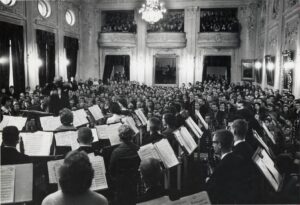
The Symphony Band performing a concert at the Leningrad Conservatory during the 1961 tour.
In the fall of 1970, Revelli began his final year at Michigan; he was mandated by state law to retire once he reached the age of 69. That fall, an oboist and band member in the School of Music named Carl Grapentine auditioned to be the Marching Band announcer at football games, and Grapentine has been the voice of the Michigan Marching Band ever since. (Grapentine expanded his role in 2006, lending his warm, booming voice to the role of play-by-play announcer as well.) Looking back on his 53 seasons with the MMB, Grapentine noted, “I’ve worked with twelve different Marching Band directors, and they’re all wonderful people and really excellent musicians.” In the spring of 1971, the Symphony Band went on another international tour, this time to the great cities of Europe. Again, the tour concluded with a performance at Carnegie Hall, an emotional end to Revelli’s 36 years as director of bands.
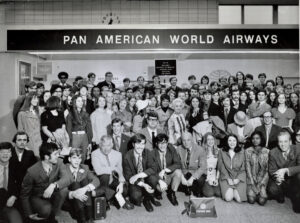
The Symphony Band prepares to depart for the 1971 European tour. Photo credit: Joseph Dobos
Fifty Years of Women in the MMB
One year following Revelli’s retirement, the role of director of bands was filled by George Cavender, who had served as assistant director for many years. Cavender led the effort to have a new, state-of-the-art rehearsal hall constructed for the MMB, a building appropriately named Revelli Hall. His first season as director was marked by perhaps the most significant shift in the history of the MMB: thanks to the requirements of Title IX, the federal civil rights law dictating that educational institutions receiving federal funding could not discriminate on the basis of sex, women were admitted to the MMB for the first time in its nearly 80-year history.
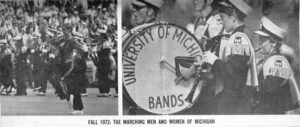
The first women in the MMB, fall 1972.
Twelve women joined the band in 1972, 50 years ago this season. One of the 12 was Lynn Hansen, who was named section leader and rank leader of the tenor saxophone section. She recalled that the men in the band were very encouraging and supportive; the women expected that, at certain moments, “there might be a little condescending remark here and there,” but “the guys would not have it…and we felt completely supported.” Reflecting on that season, she said, “I feel so grateful to have been one of the first to just get in there and get started and be able to pursue my dreams.” Recalling that Cavender was initially hesitant about the change, Dobos related that Cavender soon acknowledged that “admitting women into the Michigan Marching Band was the greatest thing that ever happened to the band.
H. Robert Reynolds Takes the Baton
A short time later, in 1975, Cavender became the director of the MMB, and a new director of bands – former student H. Robert Reynolds (BM ’56, music education, and MM ’58, wind instruments) – was brought in. Just as his predecessors had done, Reynolds propelled the band program forward, continually raising standards and broadening the program’s mission. Leaving behind the military style of the bands under previous directors, Reynolds instituted a professional model for the program. Prior to his tenure, the Symphony Band gave few performances; Reynolds expanded that number, determined to give students more performance opportunities. In a very visible embodiment of his philosophy, he got rid of the military-style uniforms for Symphony Band members, requiring them instead to wear tuxedos. Michael Haithcock, the current director of university bands and Arthur F. Thurnau Professor of Music, noted the initial shock over this decision: “When Bob switched to tuxedos, there was a big hue and cry.”
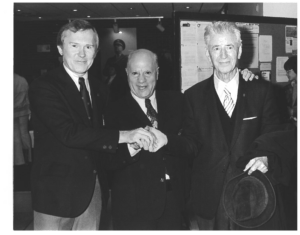
H. Robert Reynolds (left) poses with his predecessors, William Revelli and Nicholas Falcone, 1975.
With an eye toward the future of the program and concert bands generally, Reynolds used a portion of the proceeds from Band-O-Rama, which had become an annual event under Revelli, to establish a commissioning fund. The fund, which was named the H. Robert Reynolds Band Commission Endowment Fund upon the occasion of his retirement, commissioned or co-commissioned nearly 40 works during Reynolds’s era, and continues to be used for new commissions today. “What better way,” Reynolds noted, “to pull the band into the mainstream of serious concert music than to commission serious original band music?”
Like Revelli, Reynolds led the Symphony Band on significant tours, including a 1997 tour of the East Coast that culminated in a concert at Carnegie Hall and a 1987 trip to Germany with the brass players to perform – with ensembles from France and England and the Berlin Philharmonic – in celebration of the 750th birthday of Berlin. Perhaps the most notable expedition he led was a six-week tour of Europe in 1984. The centerpiece of that trip was the Symphony Band’s performance in avant-garde composer Karlheinz Stockhausen’s newest opera, Samstag aus Licht, a production presented by La Scala, one of the world’s most renowned opera houses, in Milan, Italy. This performance, in which band members were seated in five vertical layers of scaffolding, was a historic one: the Symphony Band was the first ensemble other than La Scala’s own to perform in a La Scala production.

The Symphony Band poses for a group photo during the 1984 European Tour, with Reynolds seated at the far left in the front row.
Those fortunate enough to be part of that tour, as with other international tours in U-M band history, had an unforgettable, life-changing experience. In a booklet published afterward about the tour, Reynolds wrote, “The musical respect for the abilities of all, both individually and collectively, was only outdone by the genuine closeness we all came to feel as human beings.” This past summer, thirty-eight years after the tour, dozens of participants in the 1984 tour, including Reynolds, gathered for a reunion weekend in Ann Arbor. They visited their old haunts, including Hill Auditorium and the Earl V. Moore Building, caught up on each other’s lives, and reminisced. During the reunion, the alumni announced the establishment of the H. Robert Reynolds Scholarship in Music to honor their former band conductor.
In thinking about his career as director of bands at U-M – one distinguished by honors and accolades – Reynolds said that what he is most proud of is “changing the culture of the University of Michigan band program.” He followed the intensity of the Revelli years with a gentler approach, while still challenging his students to meet extremely high standards. Rehearsals, in his mind, should go beyond simply honing musicians’ skills; they should be “in-depth experiences” that help musicians develop an intuitive knowledge of creating music that stirs the soul. “That’s where music lives: in that intuitive sense,” he noted.
Haithcock Ushers the Band Program into the Twenty-First Century
When Reynolds retired in 2001, Haithcock became director of bands, after spending 23 years on the faculty of Baylor University. Just as Reynolds led the bands in a new direction in the wake of Revelli’s departure, so did Haithcock make significant contributions to the program following Reynolds’s retirement. Musing on the history of the bands’ notable directors, Joe Dobos noted that “every generation builds on the previous one and keeps adding to [the program] and changing it to meet the times. We’ve had 125 years of always having the right person at the right time to meet the needs that we had.”
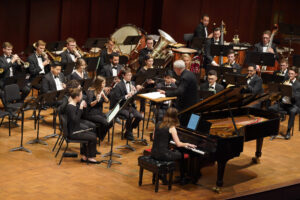
Michael Haithcock conducts the Symphony Band.
Haithcock has approached his role with multiple goals, including upholding the program’s high artistic standards for both musicians and conductors, contributing substantially to the band repertoire through commissions, and raising the profile of the band program.
Part of his mission to ensure that U-M remains one of the country’s premier band programs involved bringing on board the right people to lead. He named Courtney Snyder, associate professor of music, as the associate director of bands, the first woman to hold that position. He has overseen the hiring of several directors of the MMB and athletic bands, including current director John Pasquale, the Donald R. Shepherd Clinical Associate Professor of Conducting, who has held the position since 2013. Haithcock has also, in his own specific style, ensured that his students meet exacting standards. Speaking of the U-M band program, Dobos described such standards as “the Michigan band difference.” He explained, “the Michigan band takes time doing teeny, tiny little detailed work that people would never even notice if it was wrong or right. But they take the time to do it, because it’s the right thing to do, and that’s what makes the difference.”
Haithcock has also prioritized the commissioning of new works, a process that often involves the composer coming to campus to work directly with students. These commissions both contribute to the repertoire and give students the invaluable experience of meeting and interacting with living composers. He often collaborates on new commissions with School of Music, Theatre & Dance composition faculty and students. In all, 115 pieces have either been commissioned or premiered under Haithcock’s directorship.
To ensure that U-M bands remained at the forefront of collegiate band programs and had a profile to match, Haithcock arranged for 10 CD recordings of the Symphony Band (“before CDs became coasters,” he noted). In 2011 he established the Symphony Band YouTube channel, which has had more than 2.5 million views and has more than six thousand subscribers – “which is not a lot if you’re Beyonce,” he noted, “but for us it’s a lot of folks.” He built up the doctoral conducting program that had its beginnings under Reynolds, seeking to construct “a really vibrant program and make Michigan graduates key in the field,” he said. Haithcock’s former students are now directors of bands at schools all over the country, including University of Illinois, University of Minnesota, and University of Colorado.
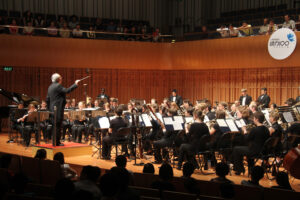
The Symphony Band, conducted by Michael Haithcock, performs at the Xi-an Concert Hall in China during the 2011 tour. Photo credit: Mark Clague
One event during Haithcock’s tenure that both reflected the sterling reputation of the U-M band program and heightened it was the Symphony Band’s 2011 tour of China. Timed to coincide with the 50th anniversary of Revelli’s Soviet Union tour, the China tour took three years to plan and was, Haithcock said, “an incredible experience in musical ways, cultural ways, and personal ways.” Haithcock pointed out, however, that each year he has been at U-M has been filled with unforgettable encounters. “We get dreamy about these tours because they’re so impactful in the moment…but as much as I had this terrific mountaintop experience, I don’t want to diminish in anyone’s mind the quality of the students in the years before and the years after. The quality of the students I’ve been fortunate enough to work with here both as musicians and as people has been a consistent joy.”
Haithcock has announced that he will retire at the end of the 2022–23 academic year, having served for 22 of the band program’s 125 years. As he prepares to hand the reins to the next director of bands, he summed up his most important goal over the past two-plus decades:
“To make sure that every student who played in Symphony Band, every student who participated in Marching Band, every student who came through our halls connected with the band program had an exemplary experience. Whatever students feel about having been connected to the band program when they walk away, that’s our legacy.”

